Florida’s limestone-rich terrain might be famous for fossilized shark teeth and coral, but there’s a lesser-known treasure, like turquoise, that catches many rock enthusiasts by surprise.
However, most People don’t know where to start looking, often wasting hours in the wrong locations.
We’ve done the legwork and talked to local rockhounds who’ve been searching these grounds for decades. Here, we’ll share their trusted spots where you’re most likely to find turquoise.
How Turquoise Forms Here
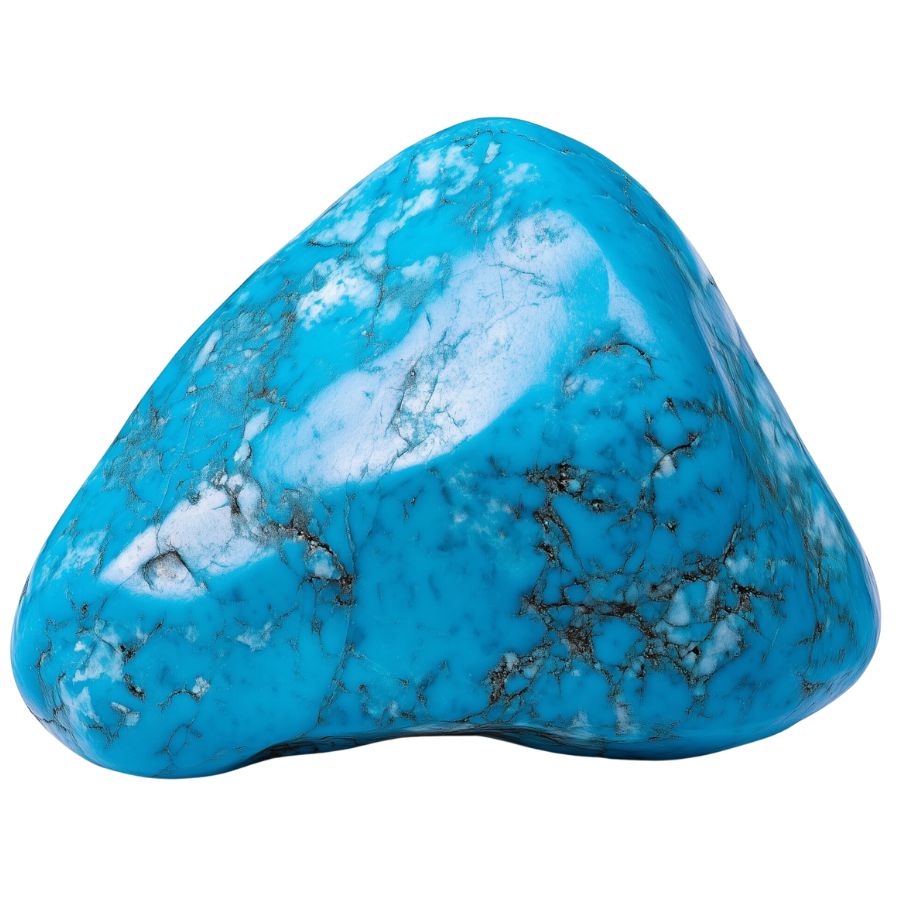
Turquoise forms through a unique process involving water and minerals. It begins when acidic water seeps into the ground, moving through rocks that contain copper and aluminum.
As this water interacts with these minerals, it breaks them down and allows the copper and aluminum to combine with phosphorus, creating turquoise.
This usually happens in shallow areas, often less than 20 meters deep, where the environmental conditions are just right.
This mineral typically fills cracks and cavities in rocks, often in dry, desert-like areas. The presence of iron can also influence its color, giving it beautiful shades of blue and green.
Over time, the turquoise hardens, resulting in the stunning gem we see today, prized for its vibrant hues and unique patterns.
The Types Of Turquoise Found in the US
Turquoise comes in a variety of stunning types, found in the US as well as in our state. Here are the types of turquoise found in the US:
Kingman Turquoise

Kingman Turquoise showcases a vibrant range of colors from pale green to deep “high blue.” Its matrix patterns can include white, light brown, or black veining, setting it apart from other turquoise types.
This stone is often stabilized to enhance its durability and color, allowing for broader use in jewelry making. The natural Kingman turquoise typically presents a medium blue hue with a water web matrix.
Kingman Turquoise is recognized as one of the most sought-after American turquoise. Its consistent supply has made it a staple in Native American jewelry and artisan crafts, contributing to its ongoing popularity.
Carico Lake Turquoise

Carico Lake Turquoise is known for its clear robin’s egg blue to vibrant lime green colors. It often features a unique spider-web matrix in brown or, more rarely, black, adding texture and shine to the stone.
What makes this stone special is its high zinc concentration, which gives it an electric lime-green hue. This color is both rare and desirable among turquoise varieties.
Gem-quality Carico Lake Turquoise is scarce, making up less than 3% of the mine’s annual output. This rarity, combined with its natural beauty, makes it a prized item for collectors and enthusiasts alike.
Lone Mountain Turquoise

Lone Mountain Turquoise is known for its bright blue to deep green colors, often featuring intricate spider web matrix patterns. These fine lines create a web-like design, enhancing its visual appeal.
This stone stands out for its exceptional hardness and color retention. It maintains its vibrant hue over time, a quality not common in all turquoise varieties.
Lone Mountain Turquoise is highly valued in the collector’s market, second only to Lander Blue Turquoise. Its ability to produce high-quality spider web turquoise makes it a favorite among jewelry artisans and collectors.
Morenci Turquoise
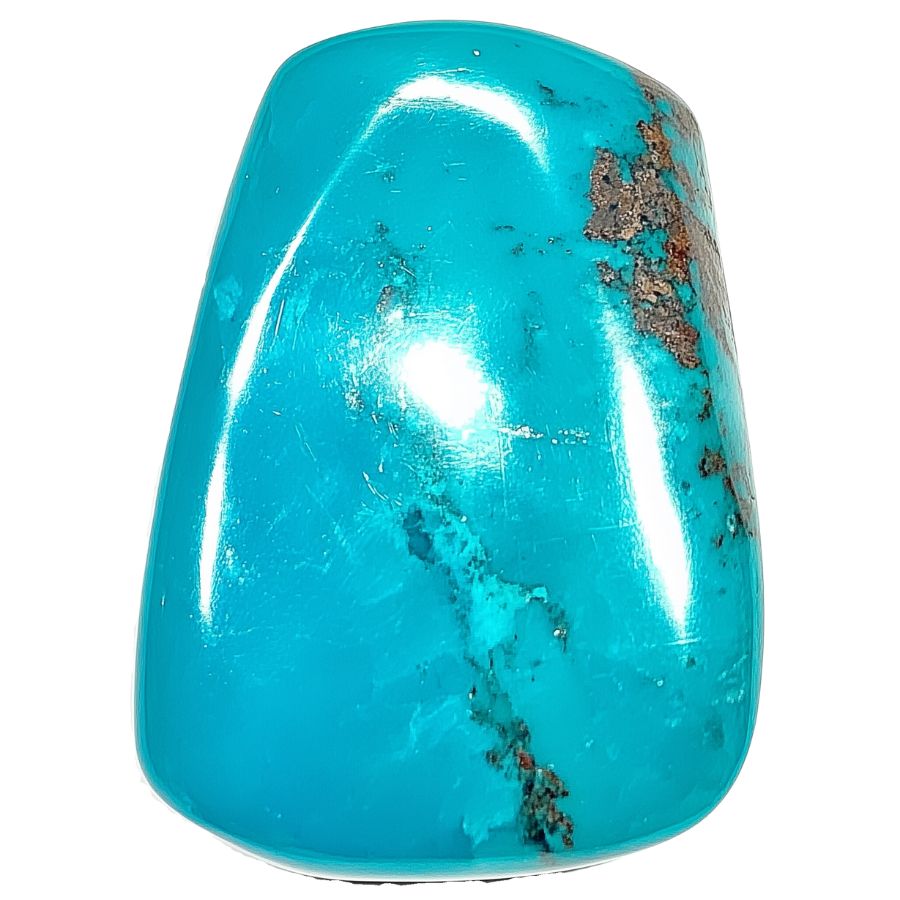
Morenci Turquoise stands out with its deep blue color, a result of its high copper content.
Its most striking feature is the iron pyrite matrix, which gives it a metallic shimmer when polished. Some pieces also show a water web matrix, creating dark blue webbing patterns.
This stone is no longer mined, making it rare and highly collectible. All available Morenci Turquoise comes from mining operations that stopped in 1984.
High-grade pieces, known for vibrant blues and pyrite matrix, make up less than 10% of the total yield.
Pilot Mountain Turquoise
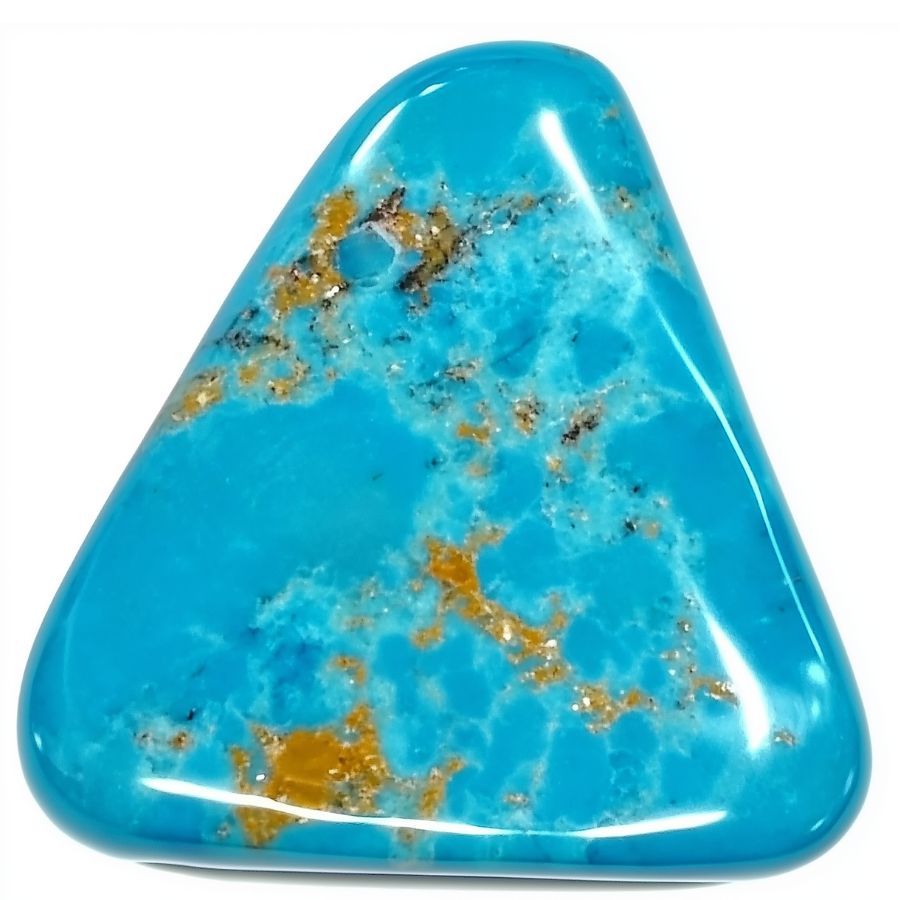
Pilot Mountain Turquoise catches the eye with its bright to dark blue hues, often showing a greenish tint.
What makes it special is its brownish-red limonite matrix, creating beautiful mottled patterns. The stone forms in hard veins, thin seams, or nuggets.
This turquoise has an interesting history, first mined around 1930. It’s known for its limited availability, with only 150 to 200 pounds of rough stone extracted twice a year. This scarcity adds to its appeal.
The unique mottled patterns of the limonite matrix make Pilot Mountain Turquoise a favorite for decorative pieces and jewelry.
Sleeping Beauty Turquoise

Sleeping Beauty Turquoise is famous for its vivid sky-blue color. Unlike many other turquoise types, it has little to no veining or matrix, giving it a pure, consistent look. The color can range from light robin’s egg blue to deeper sky blue.
This stone is naturally hard, which means it doesn’t need stabilization for use in jewelry. This quality makes it popular with jewelers. The Sleeping Beauty mine closed in 2012, making the stone rarer and more valuable.
Sleeping Beauty Turquoise became a hit in the 1970s and 80s, used in both Native American jewelry and mainstream fashion. Its consistent quality and vibrant color have made it a standard in Southwestern jewelry.
Bisbee Turquoise
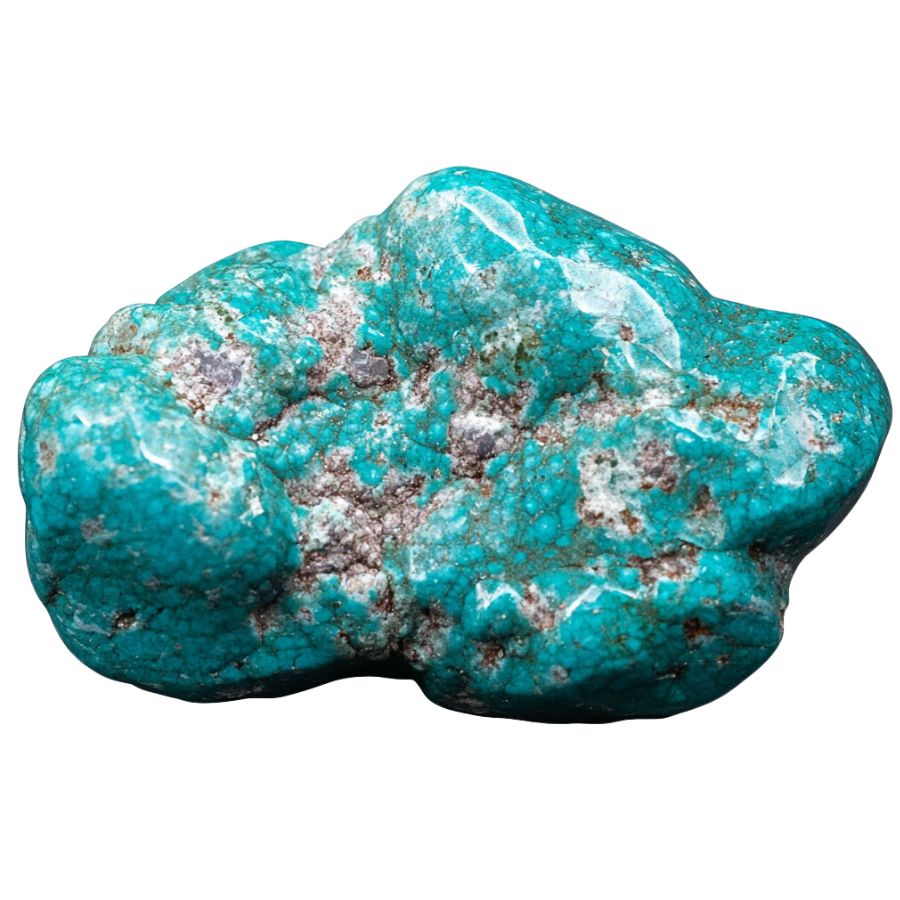
Bisbee Turquoise stands out with its vibrant blue shades, ranging from deep indigo to light robin’s egg blue. Green hues are less common but still occur.
Its distinctive matrix often displays a striking spiderweb pattern against a reddish-brown backdrop.
This stone’s unique appearance comes from its host rock color and gloss. Unlike some turquoise with metallic matrices, Bisbee’s matrix is typically more earthy and varied in color.
Bisbee Turquoise is highly valued for its quality and rarity. Its historical significance, being one of the oldest turquoise sources in North America, adds to its appeal among collectors and enthusiasts.
Royston Turquoise

Royston Turquoise is a gem of many faces. Its colors can shift dramatically, even within a single stone.
You might find a piece that starts as a soft blue and gradually transforms into a rich green. This color play is a hallmark of Royston Turquoise.
The stone’s matrix is equally fascinating. The matrix can create intricate landscapes within the turquoise, resembling golden sunsets or stormy skies.
Royston Turquoise is also known for its ability to take an exceptionally high polish. This quality, combined with its natural hardness, makes it a favorite for jewelry that can withstand daily wear.
Dry Creek Turquoise

Dry Creek Turquoise stands out with its pale pastel blue color, similar to Larimar. It often has light brown, golden yellow, or orange webbed matrices, adding to its beauty.
Unlike many turquoise types, it’s naturally hard and takes a stunning polish without treatment.
This stone is quite rare. It was discovered in the 1990s in an area with low levels of heavy metals. These metals usually give turquoise its bright colors. The unique geological setting results in Dry Creek’s captivating pale blue hue.
The natural hardness and ability to take a high polish make Dry Creek Turquoise special.
Ithaca Peak Turquoise

Ithaca Peak Turquoise is known for its stunning range of blues. It can be light blue with black spider-webbing or deep rich blue with black matrix.
Some pieces even have quartz matrix and pyrite inclusions. The most valued stones have vibrant to dark blues with good pyrite inclusions.
What makes this stone unique is its pyrite. In Ithaca Peak Turquoise, the pyrite often has a brassy color. This helps tell it apart from similar stones like Morenci turquoise.
Recently mined Ithaca Peak Turquoise looks different from older pieces. The new stones are lighter blue to green and usually don’t have a webbed matrix. This change in appearance over time adds to the stone’s interesting history.
What Raw Turquoise Looks Like
When you’re going to collect the raw turquoise, it’s important to know what to look for. Let’s talk about how you can identify genuine raw turquoise.
You only need to know a few things in order to find it, but having a guide will be very helpful.
If you want REAL results finding incredible rocks and minerals you need one of these 👇👇👇
Finding the coolest rocks in isn’t luck, it's knowing what to look for. Thousands of your fellow rock hunters are already carrying Rock Chasing field guides. Maybe it's time you joined the community.
Lightweight, mud-proof, and packed with clear photos, it’s become the go-to tool for anyone interested discovering what’s hidden under our red dirt and what they've already found.
Join them, and make your next rockhounding trip actually pay off.
What makes it different:
- 📍 Find and identify 140 incredible crystals, rocks, gemstones, minerals, and geodes across the USA
- 🚙 Field-tested across America's rivers, ranchlands, mountains, and roadcuts
- 📘 Heavy duty laminated pages resist dust, sweat, and water
- 🧠 Zero fluff — just clear visuals and straight-to-the-point info
- ⭐ Rated 4.8★ by real collectors who actually use it in the field
Look for the Blue-Green Color

The color is the big clue. Rough turquoise is often blue or green, sometimes with hints of both.
The blue comes from copper, while the green hints at more iron or other minerals.
Real turquoise tends to have a more vibrant, consistent color. If it looks too perfect, like solid blue or green with no variations, be cautious. Nature isn’t that perfect!
Assess the Density and Weight
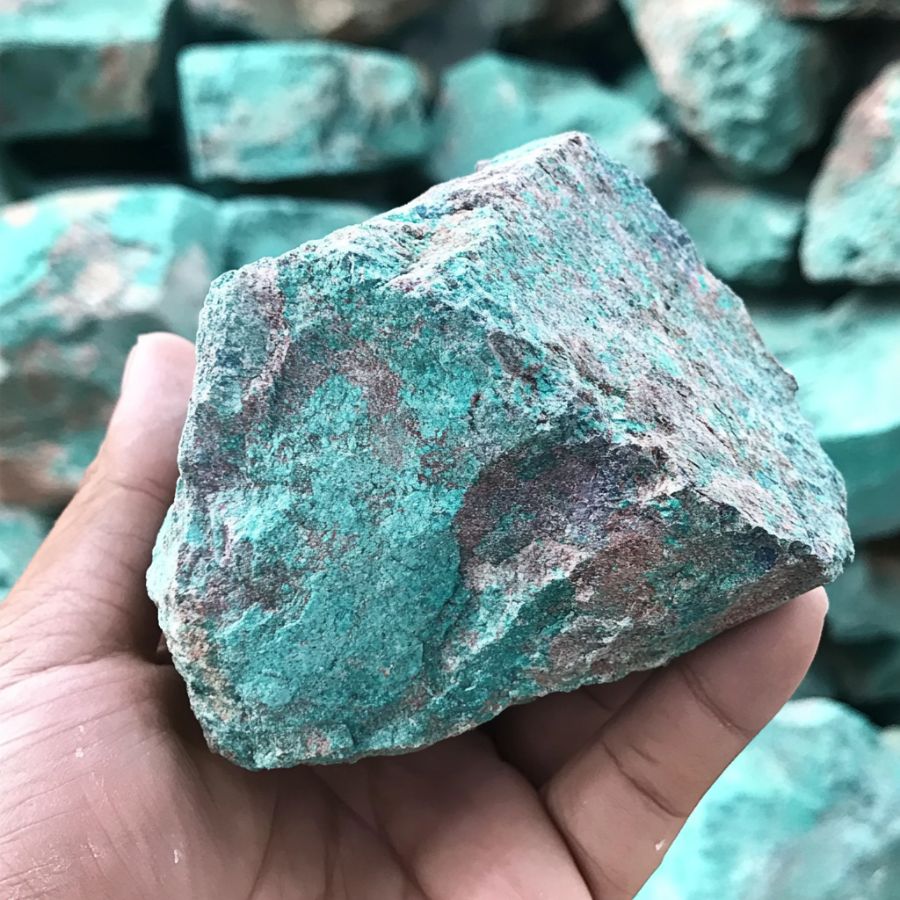
Pick up the stone and feel its weight. Real turquoise is pretty dense, so it feels heavier than it looks. If the stone feels too light, it might not be genuine.
Authentic turquoise has a specific gravity of about 2.5 to 2.9, making it heavier than many imitations.
The density comes from the minerals packed tightly together over millions of years. A heavier stone usually means a better-quality piece.
Check for a Glassy or Waxy Luster

Rough turquoise often has a glassy or waxy luster, not too shiny but not dull either. When you hold it up to the light, the surface might have a soft, smooth sheen. This luster is key.
A rough piece with a good luster usually indicates that it’s real turquoise and not a fake. You’ll notice that it reflects light in a muted way, not too bright.
Consider the Stone’s Shape and Texture

Rough turquoise isn’t always smooth. It often has a bumpy, uneven texture because it forms in cracks and crevices of other rocks.
The stone’s shape might be irregular or lumpy. This natural texture is a telltale sign that you’re holding real turquoise and not a polished or treated piece.
A Quick Request About Collecting
Always Confirm Access and Collection Rules!
Before heading out to any of the locations on our list you need to confirm access requirements and collection rules for both public and private locations directly with the location. We haven’t personally verified every location and the access requirements and collection rules often change without notice.
Many of the locations we mention will not allow collecting but are still great places for those who love to find beautiful rocks and minerals in the wild without keeping them. We also can’t guarantee you will find anything in these locations since they are constantly changing.
Always get updated information directly from the source ahead of time to ensure responsible rockhounding. If you want even more current options it’s always a good idea to contact local rock and mineral clubs and groups
Tips on where to look
Once you get to the places we have listed below there are some things you should keep in mind when you’re searching:
Riverbeds

Look for turquoise in riverbeds. Over time, water flow can expose hidden stones.
Sediment may hold the gems you’re after. Be prepared to dig through gravel and dirt to find them.
Abandoned Mines
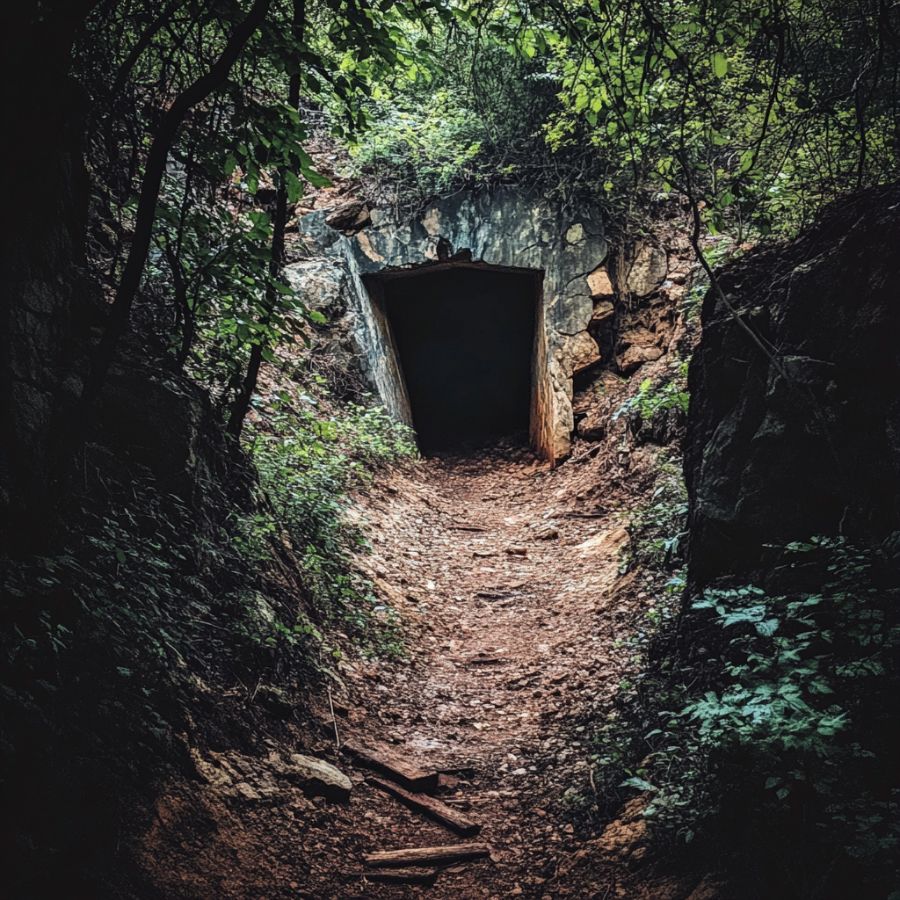
Old mines can be treasure troves for turquoise. These sites often have loose rocks where turquoise might be hiding.
Always be careful while exploring abandoned areas, though.
Hillsides

Check hillsides, especially where erosion is visible. Rain and wind can uncover layers of earth, exposing turquoise.
It’s a bit of a hunt, but it can be rewarding. Sometimes, you’ll find small stones just lying on the surface.
Rocky Outcrops

Rocky outcrops are great places to search. They are full of minerals and might have turquoise.
Explore the cracks and crevices. Turquoise often hides in these tight spaces.
Some Great Places To Start
Here are some of the better places to start looking for Turquoise in Florida:
Always Confirm Access and Collection Rules!
Before heading out to any of the locations on our list you need to confirm access requirements and collection rules for both public and private locations directly with the location. We haven’t personally verified every location and the access requirements and collection rules often change without notice.
Many of the locations we mention will not allow collecting but are still great places for those who love to find beautiful rocks and minerals in the wild without keeping them. We also can’t guarantee you will find anything in these locations since they are constantly changing.
Always get updated information directly from the source ahead of time to ensure responsible rockhounding. If you want even more current options it’s always a good idea to contact local rock and mineral clubs and groups
Suwannee River
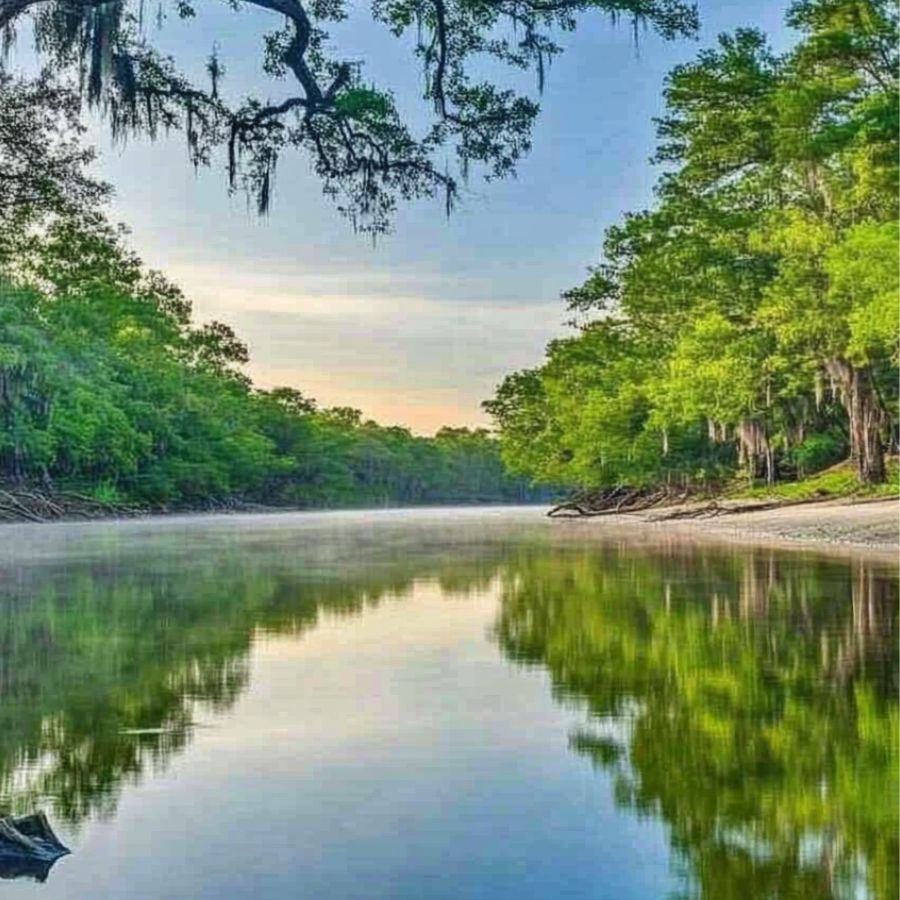
The Suwannee River flows from Georgia’s Okefenokee Swamp down through northern Florida for 246 miles until it meets the Gulf of Mexico. Known for its dark waters, this river runs through Suwannee County and creates some of Florida’s rare whitewater rapids.
The river’s unique geology features limestone layers, natural springs, and sinks. These limestone formations are filled with minerals, making them good spots to look for turquoise.
The best places to search are near the springs and along riverbanks where water has worn away the rocks over time.
The area is rich in phosphate rocks, which help form turquoise and other minerals. Rock hunters often check the limestone outcrops that stick out along the river’s edge.
Fort Drum Mine

Fort Drum Mine sits in Okeechobee County, Florida, close to Lake Okeechobee’s southern edge. This special site is about 28 miles northwest of Okeechobee city.
The mine shows off Florida’s rich geological past from about 3 million years ago. Its most exciting feature is the honey-colored calcite crystals that formed inside old clam and whelk shells. These crystals sparkle when you crack open the fossils. You won’t find this anywhere else in the world!
For turquoise, the best spot to dig is in Ruck’s Pit, where you can find various minerals. Scientists love studying this place because it helps them understand how Florida formed over millions of years.
People come from all over to collect various minerals. Each one is amazing, making them popular with rock collectors.
Peace River

The Peace River flows through southwest Florida for 106 miles, with its gravel bars in DeSoto County being a prime spot for rockhounding. The river cuts through layers of ancient sediment, creating areas rich in minerals and fossils.
While the river is more famous for its Ice Age fossils and shark teeth, its gravel bars also contain various minerals. The best spots to search are the exposed riverbanks and gravel bars, especially during the dry season from fall through early spring.
Peace River’s natural erosion process constantly reveals new material, making each visit potentially different from the last.
The river’s constant flow has created deep holes and shallow areas where minerals often collect. Local rockhounds often search after heavy rains when new materials get exposed.
Hogtown Creek

Hogtown Creek runs through Gainesville, Florida, stretching across 20 square miles of urban and natural areas. The creek flows through different environments, from pine forests to wetlands filled with ferns.
The creek’s geology makes it interesting for rock collectors. Its streambed is rich with phosphate pebbles and ancient marine fossils. The creek has several good spots for rock hunting, especially in its natural parks.
You can access the creek through three main parks: Hogtown Creek Headwaters Nature Park, Loblolly Woods Nature Park, and Alfred A. Ring Park. Each park has trails that lead to different parts of the creek.
The best time to look for turquoise and other rocks is after rain when the water washes away topsoil and exposes new material in the creek bed.
Hillsborough River

The Hillsborough River flows 60 miles through Florida, starting from the Green Swamp and ending in Tampa Bay. This river system is special because of its unique limestone formations and crystal-clear springs.
The river features interesting geological traits that make it a good spot for rock collectors. Its riverbed has exposed layers of the Tampa Member formation, which creates small rapids and rocky sections.
Crystal Springs, a large spring system, adds to the river’s mineral-rich environment. The best spots to look for turquoise and other rocks are near Crystal Springs and the upper parts of the river.
These areas have exposed rock formations and mineral deposits. The river’s geology includes silicified limestone and phosphate-rich rocks, which can hold various minerals.
Places Turquoise has been found by county
After discussing our top picks, we wanted to discuss the other places on our list. Below is a list of the additional locations where we have succeeded, along with a breakdown of each place by county.
| County | Location |
| Madison | Withlacoochee River Gravel Deposits |
| Marion | Ocala Limestone Outcrops |
| Charlotte | Shell Pits near Punta Gorda |
| Okeechobee | Taylor Creek Area |
| Levy | The Crossroads Quarry |
| Franklin | Apalachicola River Gravel Beds |
| Alachua | Alachua County Gravel Pits |
| Taylor | Gravel Pits near Perry |
| Wakulla | Ochlockonee River Gravel Sites |
| Lake | Rock Springs Creek |
| Washington | The Econfina River |
| Citrus | Crystal River Fossil Sites |
| Polk | Avon Park Formation Exposures |
| Hernando | Hernando County Lime Rock Sites |
| Miami-Dade | Miami Limestone Deposits |
| Highlands | Sand Pits near Lake Placid |
| Lee | Caloosahatchee River Fossil Beds |
| Levy | Big Bend Limestone Beds |
| Jefferson | Wacissa River Gravel Deposits |
| Putnam | Fossil Beds at St. Johns River |
| Clay | Fossil Creek Deposits near Melrose |
| Citrus | Homosassa Springs Outcrops |
| Charlotte | Shell Creek Gravel Areas |
| Alachua | Millhopper Sink Geological Sites |
| Polk | Phosphate Mines near Mulberry |
| Hillsborough | Fossil Beds along the Alafia River |



